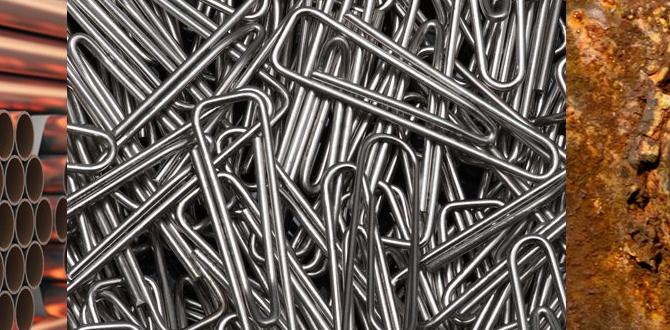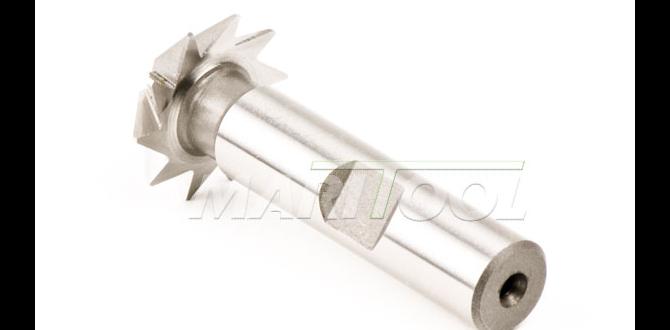Quick Summary
Achieve proven long life for carbide end mills in Inconel 625 by using specific tool geometries, appropriate speeds and feeds, robust coolant strategies, and a keen focus on minimizing vibration. Choosing the right carbide end mill, often a smaller diameter with a reduced neck and high flute count, is key to success.
Hey there, fellow makers and machinists! Daniel Bates here from Lathe Hub. Ever tried to mill Inconel 625 and felt like your tools were just melting away? You’re not alone. This superalloy is notoriously tough on cutting tools, and it can be frustrating and expensive when your carbide end mills don’t last. But don’t worry, with the right approach, we can get those tools performing beautifully and lasting much longer. We’re going to dive into the secrets of making your carbide end mills work overtime, even on this challenging material. Get ready to understand exactly what makes a difference and how to apply it in your own workshop.
Why is Inconel 625 Such a Challenge for End Mills?
Inconel 625 is a fantastic material, known for its incredible strength, resistance to corrosion, and ability to perform in extreme temperatures. That’s why it’s used in critical applications like aerospace engines, chemical processing equipment, and marine environments. However, these amazing properties make it a real beast to machine. It’s a “work-hardening” alloy, meaning it gets tougher and harder the more you cut it. This intense hardness puts immense stress, heat, and friction on cutting tools, drastically shortening their lifespan if you’re not careful. Standard machining practices just won’t cut it here!
Understanding the Enemy: The Properties of Inconel 625
Let’s break down what makes Inconel 625 so difficult:
- High Tensile Strength: It requires a lot of force to shear the material, putting a heavy load on the cutting edge.
- Work Hardening: As you machine, the material immediately adjacent to the cutting edge becomes even harder. This creates a continuous battle for the tool’s edge.
- Low Thermal Conductivity: Inconel 625 doesn’t transfer heat away from the cutting zone very well. This means the heat generated by friction stays concentrated at the tool tip, leading to rapid tool wear and potential thermal expansion issues.
- Gummy Nature: Like some other nickel-based alloys, it can be “gummy,” causing chips to adhere to the cutting edge (built-up edge or BUE), which alters the cutting geometry and can lead to tool failure.
These factors combine to create a perfect storm for cutting tools, especially standard carbide end mills. You need specialized strategies to overcome these hurdles and ensure your tools, and your project, are successful.
Choosing the Right Carbide End Mill: The Foundation for Longevity
When it comes to milling Inconel 625, not all carbide end mills are created equal. We need to select tools specifically designed for these tough, high-temperature alloys. Think of it as choosing the right tool for the right job – but for a really, really tough job!
Key Features of Effective Carbide End Mills for Inconel 625
Here are the essential characteristics to look for:
- High Flute Count: More flutes (typically 4, 5, or even 6) mean smaller chip loads per tooth. This helps manage the cutting forces and heat. For Inconel, 4 or 6 flutes are often preferred for finishing and roughing, respectively.
- Specific Carbide Grade: Not all carbides are the same. You’ll want a sub-micron or nano-grain carbide grade. These offer higher toughness and wear resistance compared to standard grades. Look for grades designed for high-temperature alloys, often specified by the manufacturer.
- Center Cutting Capability: This is a must-have. A center-cutting end mill can plunge straight down into the material, which is crucial for efficient machining strategies like helical ramping.
- Corner Radii or Chamfers: A small corner radius or a chamfer at the cutting edge helps strengthen the tip, making it less prone to chipping, especially under heavy loads.
- Reduced Neck (When Necessary): For deeper cuts, a reduced neck (where the shank is slightly smaller than the cutting diameter) provides more clearance to prevent the body of the tool from rubbing against the workpiece or chips. This is where something like a “carbide end mill 3/16 inch 8mm shank reduced neck for Inconel 625” becomes incredibly valuable, particularly for smaller features and intricate work where reach is important.
- Specialized Coatings: A high-performance coating, such as an AlTiN (Aluminum Titanium Nitride) or TiAlN (Titanium Aluminum Nitride), is crucial. These coatings add a hard outer layer to the carbide, significantly reducing friction and heat, and improving wear resistance. They also provide an oxidation barrier at high temperatures.
Choosing a tool with these features might cost a bit more upfront, but it will pay for itself many times over in tool life and reduced downtime.
Example: Tool Specifications for Inconel 625 Machining
Let’s imagine we’re looking for a tool for a specific task. For instance, milling slots or pockets in a 1/4-inch thick plate of Inconel 625, we might consider a 3/16-inch diameter end mill. Here’s what a suitable specification could look like:
| Feature | Specification for Inconel 625 | Why it Matters |
|---|---|---|
| Diameter | 3/16″ (approx. 4.76mm) | Smaller diameters can often mean lower cutting forces and better chip evacuation with adequate coolant. |
| Shank Diameter | 8mm (often a standard size matching the cutting diameter or slightly reduced) | Ensures a secure fit in the collet or tool holder. A reduced neck shank (e.g., a 3/16″ cutting head on an 8mm shank) provides clearance for deeper cuts where the tool body might otherwise interfere. |
| Flute Count | 4 or 6 | More flutes distribute the load, allowing for smaller chip loads per tooth, which is crucial for managing heat and cutting forces in Inconel. 6-flute is often good for finishing, 4-flute for roughing. |
| Material | Sub-micron Carbide | Offers superior toughness and wear resistance compared to standard carbide. Ideal for extreme hardness. |
| Coating | AlTiN or TiAlN | Forms a protective barrier, significantly reducing friction and heat, leading to much longer tool life. |
| Edge Prep | Honed edge with a small corner radius (e.g., 0.005″) or chamfer | Strengthens the cutting edge, preventing chipping and premature failure. |
| Center Cutting | Yes | Allows for plunging operations required in paths like helical ramping. |
This “carbide end mill 3/16 inch 8mm shank reduced neck for Inconel 625 long tool life” is a starting point. Always consult the tool manufacturer’s recommendations for specific grades and coatings designed for Inconel. Reputable manufacturers like Sandvik Coromant or Kennametal offer excellent resources and product lines for challenging materials.
Mastering Speeds and Feeds: The Heart of Tool Life
This is where many beginners struggle. Finding the sweet spot for speeds and feeds is absolutely critical when machining Inconel 625. Too fast, and you burn up the tool. Too slow, and you generate excessive heat through rubbing, which is also bad. It’s a delicate balance!
Understanding Cutting Speed (SFM) and Feed Rate (IPM)
- Cutting Speed (Surface Feet per Minute – SFM): This is the speed at which the cutting edge moves across the material. For Inconel 625, you’ll generally need much lower SFM values than you would for mild steel or aluminum.
- Feed Rate (Inches per Minute – IPM): This is how fast the tool is advanced into the material. More importantly, we often think of the chip load – the thickness of the chip being removed by each tooth of the end mill.
Recommended Ranges for Inconel 625
These are general guidelines, and actual values will depend on your specific machine rigidity, coolant, and tool. Always start conservatively and ramp up if possible.
| Operation Type | Cutting Speed (SFM) | Chip Load per Tooth (IPT) | Revolutions per Minute (RPM) – Example for 3/16” Tool |
|---|---|---|---|
| Roughing | 30 – 60 | 0.001″ – 0.003″ | ~600 – 1200 RPM |
| Finishing | 40 – 70 | 0.0005″ – 0.0015″ | ~800 – 1400 RPM |
RPM in table is calculated as (SFM 12) / (π Diameter). For a 3/16″ tool (0.1875″): RPM = (SFM 3.82). Always use a proper calculator or your machine’s calculator for precise values.
How to Calculate RPM
The formula is simple:
RPM = (SFM 3.82) / Diameter (inches)
For example, if you want to run at 50 SFM with a 3/16″ (0.1875″) end mill:
RPM = (50 3.82) / 0.1875 = 1018.67 RPM. So, you’d set your spindle to around 1000 RPM.
Feed Rate Considerations
The chip load is your friend here. A light chip load prevents the tool from being overloaded and helps control heat. For a 3/16″ (0.1875″) diameter, 4-flute end mill, on the higher end of SFM (say 60 SFM), with a chip load of 0.002″:
IPM = RPM Flute Count Chip Load per Tooth
Using our calculated 1019 RPM:
IPM = 1019 4 0.002 = 8.152 IPM
This might seem incredibly slow compared to machining softer materials, but it’s necessary for Inconel 625. Trust the numbers, and observe the chips!
Interpreting Your Chips
The chips you produce are your best indicator:
- Fine, powdery chips: Usually too shallow of a chip load, leading to rubbing and heat. Increase feed rate or depth of cut slightly.
- Long, stringy chips: Can indicate a feed rate that’s too high or a material that’s “gummy.”
- Bright, healthy chips: Usually indicate you’re in the ballpark. They should have a golden or tan color, not blue (too hot) or white (too much rubbing/heat).
Always refer to your specific tool manufacturer’s cutting data recommendations. Websites like Carbide Processors offer extensive machining guides for various materials.
The Crucial Role of Coolant and Lubrication
When machining Inconel 625, the heat generated is immense. Effective cooling and lubrication aren’t just nice-to-haves; they are absolutely essential for tool life. Without them, your tool edge will fail very quickly due to thermal degradation and excessive wear.
Types of Coolant Strategies
- Through-Spindle Coolant (TSC): If your machine has it, this is your best friend. High-pressure coolant delivered directly through the tool and out the flutes provides direct cooling and lubrication right at the cutting edge.
- MQL (Minimum Quantity Lubrication): This system atomizes a small amount of lubricant with compressed air but is generally less effective for Inconel 625 without specialized tooling and setups aimed at high-temp alloys.
- Flood Coolant: Standard flood coolant can help, but it needs to be applied strategically and at a good flow rate to be effective in the cutting zone.
- High-Performance Machining Fluids: Use a synthetic or semi-synthetic coolant specifically formulated for machining nickel alloys at high temperatures. These fluids have excellent cooling properties and lubricity.
Application Techniques Matter
- Direct the Nozzles: If using flood coolant, aim the nozzles directly at the point where the tool enters the material. This helps flush chips away and cool the cutting edge.
- Chip Evacuation: Good coolant flow also helps evacuate chips. Cluttered chips retain heat and act as an abrasive.
- Consider Pastes or Gels: For some operations, especially drilling or manual milling, a specialized machining paste or gel designed for Inconel can provide localized lubrication and cooling.
A common mistake is not using enough coolant or using the wrong type. For Inconel, aim for a coolant with excellent cooling capacity. For example, a fluid with a high water content (like 90-95%) and a robust package of chemical inhibitors for lubrication and corrosion is often recommended for difficult alloys. You can find detailed recommendations from coolant manufacturers like Master Fluid Solutions.
Machining Strategies for Extended Tool Life
How you approach the cut can make a massive difference. Simple, direct methods might not be the best for Inconel 625. We need to think smarter about geometry and toolpaths.
Depth of Cut (DOC) and Step-over
This is directly related to your chip load. For Inconel, you generally want to:
- Use a shallow Depth of Cut (DOC): This is the vertical distance the tool cuts into the material. Keeping DOC relatively low (e.g., 0.050″ – 0.100″ for a 3/16″ tool) helps manage heat and cutting forces.
- Use a shallow Step-over: This is the horizontal distance the tool moves between adjacent cutting paths. A smaller step-over (e.g., 20-40% of the tool diameter) means lighter chip loads per tooth and better surface finish, though it increases machining time.
High-Efficiency Machining (HEM) or Trochoidal Milling
This strategy uses a very small step-over and larger radial depth of cut, combined with a high feed rate and moderate spindle speed. The tool engages the material in a sweeping, circular motion (trochoidal path), maintaining a nearly constant, shallow chip load. This keeps the tool in a more consistent cutting zone, reduces heat buildup, and allows for better chip evacuation. Many CAM software packages have built-in functions for this.
Avoid Ramping and Helical Interpolation
While end mills can plunge, avoiding deep plunges where the tool engages the full diameter is often beneficial. Instead, use shallow helical ramping motions to enter pockets. This allows the flutes to cut chips progressively, reducing the shock load on the tool.
Back-Stepping and Retracting Wisely
When milling slots or pockets, especially with deeper cuts, consider “back-stepping.” This involves retracting the tool slightly after each pass, clearing chips, and then moving forward again. This is more relevant for deeper cuts than what a reduced neck tool might typically handle in Inconel. For shallower work with your 3/16″ reduced neck tool, focus on consistent, shallow radial engagement.
Break Up the Cut
If possible, rough out the bulk of the material with smaller, more aggressive tools







